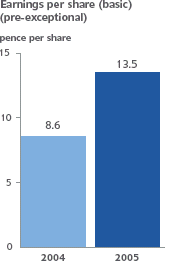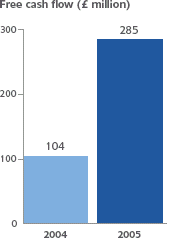
Treasury policy seeks to ensure that adequate financial resources are available for the development of the Group's business while managing its currency, interest rate and counterparty credit risks.
Our key performance indicators address two key aspects of the business: its profitability and its cash generation.
- Free cash flow increased by 174% to £285 million
- Net assets increased by £317 million to £2,375 million
- Net debt has increased by £234 million to £2,979 million
- Debt capitalisation reduced to 56%
- Gearing now at 125% from 133%
Liquidity
Free cash flow for the year ended 31 December 2005 was £285 million, an increase of £181 million compared to 2004. This increase reflects the underlying profitability of the assets acquired in 2004 and 2005 together with improving margins in the UK and US merchant markets.
Dividends from joint ventures and associates of £92 million are up £23 million from 2004, reflecting the portfolio expansion.
Capital expenditure for growth projects at £188 million principally comprises of spend on the Tihama project in Saudi Arabia, together with the Hazelwood West Field mine extension and the completion of the Canunda wind farm project.
Acquisitions of £571 million in 2005 mainly relates to Saltend, together with the retail partnership with EnergyAustralia and some final spend relating to the IPM acquisition. Disposals of £211 million relate to the sale of Tri Energy, Italian Wind and Valley Power, together with the sale of 20% of Turbogás relating to EdP pre-emption rights. Foreign exchange and other includes an exchange charge of £160 million on retranslation of net debt balances held to finance our overseas investments, which have increased by a similar amount.
In June 2005 we took the opportunity to refinance our existing corporate revolving credit facility of US$450 million to increase the size to US$640 million, extend the tenure to June 2008 (with the option to extend for a further two years, subject to agreement by the bank syndicate) and improve the commercial terms.
A summarised, reclassified presentation of the Group cash flow is set out below:
| Year ended 31 December 2005 |
Year ended 31 December 2004 |
|
|---|---|---|
| £m | £m | |
| Profit for the year (post exceptionals) | 330 | 104 |
| Adjustment for non-cash items (see note below)* | 180 | 91 |
| Dividends received from joint ventures and associates | 92 | 69 |
| Movements in working capital | (21) | 3 |
| Capital expenditure - maintenance | (72) | (59) |
| Other cash movements | 3 | - |
| Tax and interest paid | (227) | (104) |
| Free cash flow | 285 | 104 |
| Finance costs - exceptional | (5) | (26) |
| Refinancing costs capitalised on acquisition debt | (7) | (22) |
| Capital expenditure for growth projects | (188) | (158) |
| Returns from investments/capital expenditure - other financial investments | 48 | (61) |
| Acquisitions | (571) | (1,195) |
| Disposals | 211 | 17 |
| Receipt from TXU administrators - exceptional | 58 | - | Dividends paid | (37) | - |
| Proceeds from share/rights issue | 2 | 286 |
| Funding from minorities | 80 | 165 |
| Foreign exchange and other | (181) | 62 |
| Increase in net debt | (305) | (828) |
| Opening net debt | (2,745) | (692) |
| Transitional adjustment on first-time adoption of IAS 39 | 44 | - |
| Net cash/(debt) on acquisition of subsidiaries | 27 | (1,225) |
| Closing net debt | (2,979) | (2,745) |
*Non-cash items include income statement charges for interest, tax, depreciation, the share of profit of joint ventures and associates, the exceptional profit on the TXU settlement and the reversal of Rugeley impairment.
Balance sheet
A summarised, reclassified presentation of the Group balance sheet is set out below:
| As at 31 December 2005 |
As at 31 December 2004 |
|
|---|---|---|
| £m | £m | |
| Non-current assets | ||
| Intangibles and tangibles | 4,590 | 3,748 |
| Investments | 1,379 | 1,255 |
| Other long-term receivables | 623 | 664 |
| Total non-current assets | 6,592 | 5,667 |
| Net current liabilities (excluding net debt items) | (327) | (116) |
| Non-current liabilities (excluding net debt items) | (911) | (748) |
| Net debt | (2,979) | (2,745) |
| Net assets | 2,375 | 2,058 |
| Gearing | 125% | 133% |
| Debt capitalisation | 56% | 57% |
The increase in intangibles and tangibles of £842 million principally reflects the acquisition of Saltend, capital expenditure on growth projects, such as Tihama, and retranslation gains of £179 million, principally on our Australian and US dollar assets.
The increase in net current liabilities relates to £228 million of derivatives recognised in the balance sheet following the adoption of IAS 39 and provisions for power contracts that were made on the acquisition of Saltend. Under IFRS, the derivative contracts are revalued at each period end but have no impact on future cash flow.
Non-current liabilities have increased by £163 million to £911 million principally due to derivatives recognised following the adoption of IFRS and deferred tax liabilities recognised on the acquisition of Saltend.
Net debt has increased in 2005 as a result of the acquisition of Saltend and further capital expenditure at Tihama, partially offset by strong cash flow generation and the disposals of Valley Power and Italian Wind.
Net debt and capital structure
Group net debt at 31 December comprised:
| 2005 | 2004 | |
|---|---|---|
| £m | £m | |
| Cash and cash equivalents | 620 | 565 |
| Assets held for trading | 52 | 47 |
| Convertible bonds | (125) | (158) |
| Other bonds | (445) | (449) |
| Secured bank loans and preferred equity | (3,081) | (2,750) |
| Net debt | (2,979) | (2,745) |
The above net debt of £2,979 million excludes the Group's share of joint ventures' and associates' net debt of £1,625 million (2004: £1,285 million). These obligations are generally secured by the assets of the respective joint venture or associate borrower and are not guaranteed by International Power plc or any other Group company. In view of the significance of this amount, it has been disclosed separately.
The Group has sufficient credit facilities in place to fund and support adequately its existing operations and to finance the purchase of new assets. These facilities comprise a revolving credit facility and convertible bond. The revolving credit facility of US$640 million (£373 million) expires in June 2008 but can be extended by a further two years subject to bank approval. The convertible bond of US$252 million (£125 million) matures in August 2023 but with bond holders having the right to 'put' the bond back to the Group in August 2010, 2013, 2018 and 2023. In addition, the Group has uncommitted bilateral credit lines from various banks at its disposal at the corporate level.
The remaining portion of the 2% convertible bond of US$51 million (£29 million) matured in November 2005 and was fully repaid at a redemption price of 112.4% of its principal amount.
Secured non-recourse finance
The Group's financial strategy is to finance its assets by means of limited or non-recourse project financings at the asset or intermediate holding company level, wherever that is practical.
During 2005 an additional £275 million of non-recourse debt was secured in relation to the financing of Saltend. This was more than offset by a reduction in debt of £185 million relating to the disposal of assets, planned principal repayments of £56 million and TXU proceeds of £58 million which were used to repay non-recourse debt at Rugeley. Foreign exchange and other non-cash movements increased the sterling value of non-recourse debt by £160 million, principally due to the strengthening of the US dollar during 2005.
Corporate and Group debt
During 2005 both Standard & Poor's and Moody's reviewed the credit rating at corporate level. Standard & Poor's maintained the rating of BB-, but upgraded the outlook from negative to stable and Moody's maintained its rating of B2 with stable outlook. In January 2006 a rating from Fitch was issued of BB with stable outlook.
On 31 December 2005 we had aggregated debt financing of £3,651 million denominated principally in US dollars, Australian dollars, sterling, Euro, Czech koruna and Thai baht. Of this amount £187 million is due for repayment in 2006, with the majority of the remaining balance due after 2010.
Treasury and counterparty risk policy
Treasury policy seeks to ensure that adequate financial resources are available for the development of the Group's business whilst managing its currency, interest rate and counterparty credit risks. The Group's treasury policy is not to engage in speculative transactions. Group treasury acts within clearly defined guidelines that are approved by the Board. The major areas of treasury activity are set out below.
Further information on the Group's financial risk management objectives and policies are included in the Corporate governance section and in notes 32 and 33 to the consolidated financial statements.

Currency translation exposure
Consistent with the majority of other international companies, the results of the Group's foreign operations are translated into sterling at the average exchange rates for the period concerned. The balance sheets of foreign operations are translated into sterling at the closing exchange rates. In order to hedge the net assets of foreign operations, borrowings are generally in the same currency as the underlying investment. The Group aims to hedge a reasonable proportion of its non-sterling assets in this way.
It is our policy not to hedge currency translation through foreign exchange contracts or currency swaps. Average and year-end sterling rates for major currencies, which are significant to the Group, were:
Average |
At 31 December |
|||
|---|---|---|---|---|
| 2005 | 2004 | 2005 | 2004 | |
| US dollar | 1.82 | 1.83 | 1.72 | 1.92 |
| Australian dollar | 2.39 | 2.48 | 2.34 | 2.45 |
| Euro | 1.46 | 1.46 | 1.46 | 1.41 |
| Czech koruna | 43.56 | 46.91 | 42.27 | 42.87 |
Currency transaction exposure
This arises where a business unit makes actual sales and purchases in a currency other than its functional currency. Transaction exposure also arises on the remittance from overseas of dividends or surplus funds. The Group's policy is to match transaction exposure where possible, and hedge remaining transactions as soon as they are committed, by using foreign currency contracts and similar instruments.
Short-term deposits
Surplus funds are placed for short periods in investments that carry low credit risk and are readily realisable in major currencies.
Interest rate risk
The Group's policy is to fix interest rates for a significant portion of the debt (61% as at 31 December 2005) using forward rate or interest rate swap agreements. Turbogás interest costs are a pass through in the PPA tariff and therefore not an exposure to the Group: adjusting for this item would increase fixed rate debt to 69%. The level of fixed interest rate debt has increased in 2005 as the hedging strategy for the EME international portfolio was implemented in January 2005. Significant interest rate management programmes and instruments require specific approval of the Board. The weighted average interest of the fixed rate debt was 7% in 2005. Where project finance is utilised, our policy is to align the maturity of the debt with the contractual terms of the customer offtake agreement.
Counterparty credit risk
The Group's policy is to manage its credit exposure to trading and financial counterparties within clearly defined limits. Energy trading activities are strictly monitored and controlled through delegated authorities and procedures, which include specific criteria for the management of counterparty credit exposures in each of our key regions. Counterparty exposure via customer offtake agreements is monitored and managed by the local asset team with assistance from Group Treasury where appropriate. In addition, Group Treasury manages the Group-wide counterparty credit exposure on a consolidated basis, with the active and close involvement of the global risk manager. Financial counterparty credit exposure is limited to arrangements with relationship banks and commercial paper with companies which have strong investment grade credit ratings.
International Financial Reporting Standards
Under EU legislation, all listed companies are required to report their consolidated results under International Financial Reporting Standards (IFRS), as adopted by the EU, for accounting periods commencing on or after 1 January 2005. As a result of the need to present comparatives as well as current year numbers under IFRS, our date of transition to IFRS is 1 January 2004.
This is the Group's first annual report and accounts to be presented under IFRS. Comparative information, which was originally presented under UK GAAP in the 2004 Annual Report, has been restated on the same basis.

Overview of impact
The financial information included in the financial statements has been prepared on the basis of all applicable IFRS issued by the International Accounting Standards Board and adopted by the EU. As required by IFRS 1 (First-time Adoption of International Financial Reporting Standards) the Group is required to explain how the transition from UK GAAP to IFRS has affected its reported financial position and financial performance. In accordance with these requirements we set out in note 42 to the accounts:
- a reconciliation of equity reported under UK GAAP to equity under IFRS as at 1 January 2004 and 31 December 2004;
- a reconciliation of the profit reported under UK GAAP for the year ended 31 December 2004 to profit reported under IFRS.
IFRS 1 states that an entity shall use the same accounting policies in its opening IFRS balance sheet, throughout all periods presented in its first IFRS financial statements and for all periods presented thereafter. In order to facilitate the transition to IFRS, it also allows adoption options and exemptions in the initial application of certain IFRSs. The Group has applied the following options (which are outlined in note 1 to the financial statements):
- Business combinations prior to 1 January 2004 have not been restated (in accordance with IFRS 3 Business Combinations).
- The deemed cost of the Group’s US merchant fleet, owned by American National Power and which was impaired at 31 December 2003, has been measured at its fair value at 1 January 2004.
- Cumulative foreign exchange differences in reserves have been deemed to be zero on adoption of IFRS. Gains and losses on subsequent disposals of foreign operations will be measured by reference to their carrying values translated at 1 January 2004.
- The Group has recognised the pension schemes’ surpluses and deficits in full as at 1 January 2004, with a corresponding adjustment to reserves. The Group has used the ‘corridor’ method to recognise actuarial gains and losses arising after the date of transition.
In accordance with the exemptions available under IFRS 1, the Group has decided not to restate the comparatives to take into account the requirements of the accounting standards applicable to financial instruments (IAS 32 and IAS 39). Hence for 2004 the information presented in the financial statements in respect of financial instruments is measured, recorded and presented in accordance with UK GAAP. Derivatives have been recognised at fair value at 1 January 2005, with a corresponding charge or credit to reserves. The adjustments made to the balance sheet at 1 January 2005, to reflect the adoption of IAS 32 and IAS 39, are also outlined in detail in note 42 to the financial statements.
Those areas which have the most significant impact on the Group's reported position and financial performance during 2004 and as at 1 January 2005 under IFRS compared with the previously reported results under UK GAAP are:
- the cessation of goodwill amortisation;
- differences in accounting for deferred tax, principally with respect to fair value adjustments on acquisition;
- dividends declared and not approved at the balance sheet date - these are not included as liabilities in the financial statements;
- the present value of net pension scheme obligations recognised on balance sheet (excluding actuarial gains and losses not recognised);
- the recognition of a charge to the income statement for share-based payments;
- split accounting of convertible debt in order to recognise both debt and equity components;
- recognition on the balance sheet at fair value of all qualifying derivatives;
- deferral of fair value mark to market gains and losses within hedging reserves for qualifing cash flow hedges.
A detailed description of the IFRS transition adjustments is included in note 42.
| Accounting policy | Critical accounting judgements and key sources of uncertainty derive from the determination of the: |
|---|---|
| Income recognition |
|
| Recoverable amount of property, plant and equipment |
|
| Fair values on acquisition |
|
| Consolidation policy - amount of influence |
|
| Items of income and expense which require separate disclosure - ‘exceptional items’ |
|
| Taxation |
|
Accounting policies
A discussion follows on the policies we believe to be the most critical in considering the impact of estimates and judgements on the Group's financial position and results of operations.
Critical accounting policies and estimates
We prepare our consolidated financial statements in compliance with International Financial Reporting Standards (IFRS) issued by the International Accounting Standards Board as adopted by the European Union. As such, we are required to make certain estimates, judgements and assumptions that we believe are reasonable based upon the information available. These estimates and assumptions affect the reported amounts of assets and liabilities at the date of the financial statements, the reported amounts of revenue and expenses during the periods presented and the related disclosure of contingent assets and liabilities.
On an ongoing basis, we evaluate our estimates using historical experience, consultation with experts and other methods considered reasonable in the particular circumstances to ensure full compliance with IFRS and best practice. Actual results may differ significantly from our estimates, the effect of which is recognised in the period in which the facts that give rise to the revision become known.
Our Group accounting policies are detailed in note 1 to the consolidated financial statements. The table above identifies some of the areas where significant judgements are required, normally due to the uncertainties involved in the application of certain accounting policies.
Income recognition
The majority of our income is derived from owning and operating power plants worldwide. In merchant markets the Group enters into various types of hedging or forward contracts for the buying and selling of commodities related to this activity: principally sales of electricity and the purchase of fuel for its own power plants. These contracts typically fall within the definition of derivative financial instruments and where required have to be marked to market. Accounting for these contracts as cash flow hedges allows, to the extent the hedge is effective, the changes in value of the derivatives to be deferred in equity. In order to achieve cash flow hedge accounting it is necessary for the Group to determine, on an on-going basis, whether a forecast transaction is both highly probable and whether the hedge is effective. This requires both subjective and objective measures of determination.
When our power plants sell their output under long-term purchase agreements it is usual for the power plant owning company to receive payment (known as a 'capacity payment') for the provision of electrical capacity whether or not the offtaker requests electrical output. In these situations, where there is a long-term contract to purchase electricity output and electrical capacity, it is necessary for the Group to evaluate the contractual arrangements and determine whether they constitute a form of lease or a service contract. Where the arrangements are determined to be a form of lease an evaluation is then required of where the substantial risks and rewards of ownership reside in order to determine the form of lease it represents. For those arrangements determined to be finance leases, it is necessary to calculate the proportion of total capacity payments which should be treated as finance income, capital repayment and as a fee for service provision and for operating leases the split between rental payments and fees for service provision.
The Group receives amounts from contractors in respect of late commissioning and under performance of new power plants. Receipts which relate to compensation for lost revenue are treated as income when the compensation is due and payable by the contractor. Those receipts that relate to compensation for plants not achieving long-term performance levels specified in the original contracts are recorded as a reduction in the cost of the assets.
Recoverable amount of property, plant and equipment
The original cost of greenfield developed power plant and other assets includes relevant borrowings and development costs:
- Interest on borrowings relating to major capital projects with long periods of development is capitalised during construction and then amortised over the useful life of the asset.
- Project development costs (including appropriate direct internal costs) are capitalised when it is virtually certain that the project will proceed to completion and income will be realised.
Depreciation of plant is charged so as to write down the value of the asset to its residual value over its estimated useful life:
- Gas turbines and related equipment are depreciated over 30 years to a 10% residual value, unless the circumstances of the project or life of specific components indicate a shorter period or a lower residual value.
- Coal and hydro plant is considered on an individual basis. Management regularly considers whether there are any indications of impairment to carrying values of property, plant and equipment and other assets (e.g. the impact of current adverse market conditions). Impairment reviews are generally based on risk adjusted discounted cash flow projections that require estimates of discount rates and future market prices over the remaining lives of the assets.
Fair values on acquisition
The Group is required to bring acquired assets and liabilities on to the Group balance sheet at their fair value. Power plant and equipment usually have long operating lives, and are often bought with associated long-term contracts such as PPAs. Hence determination of the fair values of these long-life assets and contracts can require a significant amount of judgement.
Consolidation policy - amount of influence
The determination of the level of influence the Group has over a business is often a mix of contractually defined and subjective factors that can be critical to the appropriate accounting treatment of entities in the consolidated accounts. We achieve influence through Board representation and by obtaining rights of veto over significant actions. We generally treat investments where the Group holds less than 20% of the equity as investments available for sale. These investments available for sale are carried at market value where market prices are available. Where quoted market prices in an active market are not available, and where fair value cannot be reliably measured, unquoted equity instruments are measured at cost.
Where the Group owns between 20% and 50% of the equity of an entity and is in a position to exercise significant influence over the entity's operating and financial policies, we treat the entity as an associate or jointly controlled entity. Equally, where the Group holds a substantial interest (but less than 20%) in an entity and has the power to exert significant influence over its operations, we treat it as an associate or jointly controlled entity.
Exceptional items
The Directors consider that items of income or expense which are material by virtue of their nature and amount should be disclosed separately if the financial statements are to fairly present the financial position and financial performance of the Group. The Directors label these items collectively as ‘exceptional items’.
Determining which transactions are to be considered exceptional in nature is often a subjective matter. However, circumstances that the Directors believe would give rise to exceptional items for separate disclosure would include:
- disposals of investments;
- discontinued operations;
- impairments and impairment reversals.
All exceptional items are included under the appropriate income statement line item to which they relate. In addition, for clarity, separate disclosure is made of all such items in one column on the face of the income statement.
Taxation
The level of tax provisioning is dependent on subjective judgement as to the outcome of decisions to be made by the tax authorities in the various tax jurisdictions in which International Power operates.
It is necessary to consider the extent to which deferred tax assets should be recognised based on an assessment of the extent to which they are regarded as recoverable.

Key performance indicators (KPIs)
Our financial KPIs address two key aspects of the business, its profitability and its cash generation.
Earnings per share (EPS)
EPS is a measure of the profitability of the Group and shareholder returns. Growth in profitability over time is indicative of the ability of the Group to add value. The Directors consider pre-exceptional EPS as the appropriate indicator of performance as it excludes significant items which, by virtue of their size or incidence, could potentially distort the year-on-year comparison.
2005 EPS (excluding exceptional items) at 13.5p is 57% ahead of 2004. This increase results from the continued recovery in the UK and US merchant markets together with an excellent performance from the assets acquired in 2004 and 2005.
Free cash flow
Power generation is a capital intensive business and hence it requires the assets within the Group to generate sufficient cash to repay the initial investment in the assets, to provide returns for shareholders and to provide funds for future investment opportunities. The Directors consider free cash flow to be the appropriate indicator of cash generating performance as it measures the cash generated from operating activities, excluding those cash flows relating to exceptional items.
Free cash flow in 2005 at £285 million is 174% ahead of 2004. This increase also reflects the underlying profitability of the acquired assets together with the improving margins in the UK and US merchant markets.
 |
 |
This page includes links to documents in Portable Document File (PDF) format. To read PDF documents you may need to download the free Adobe Acrobat Reader. For PDF accessibility help, visit Access Adobe. These links will open in a new browser window.

